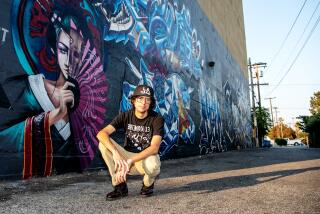A Larger Picture of Muslim Life
The life of Asma Ahmad, a Pakistani who grew up in Saudi Arabia attending American-run schools, has long been a cross-cultural event.
Now 26, she lives in Orange County and wears the flowing robes and a scarf more in favor with Muslim women in the Middle East than with her neighbors in Irvine.
While wearing the traditional attire, she works in a tiny Anaheim office not far from Disneyland. Ahmad is the editor of Southern California in Focus, an Islamic newspaper launched earlier this year to cover the growing and diverse Muslim community. In most Islamic countries, her job would be usually filled by men.
âItâs a newspaper for American Muslims,â she said. âWe want to bring out a diversity of issues that are important to the community and write about the contributions that non-Muslims are making.â
Ahmad is targeting a wide audience. Southern California has an estimated 500,000 Muslims living from Santa Barbara to San Diego. âThe Muslim community is diverse and rich in the background of its members,â she said. âMuslims come in different colors and speak different languages.â
What sets Ahmadâs fledgling publication apart from a handful of papers that serve local Muslims is its broad coverage, including news, obituaries, short profiles of Muslim artists and investment advice for Muslims, whose religion prohibits usury. Also, all of the articles are in English. Most papers that serve the community are in both English and Arabic.
âThis is what the community needed. Thereâs a lot of Muslims who donât read Arabic, and English is the common language among Muslims here. It seems that the paper is going to be very active in covering the community. Plus it will help non-Muslims understand us better,â said Garden Grove bookstore owner Jarir Saadoun.
Ahmad said her parents encouraged her to expand her horizons through education, and that brought her to America. She is a Canadian citizen, but, having been around Americans all of her life, her world is also colored with American values.
In a recent meeting with a visiting newsman at her paperâs office, Ahmad talked about a bridge between the Islamic world and the West.
She offered her visitor a warm greeting, but her hands were clasped behind her back, a sign that she follows the traditional Muslim practice of not shaking hands with men. But Ahmad quickly pointed out that the paper was not traditional in its coverage.
The February issue carried a story about a hip-hop concert in the San Fernando Valley featuring the Muslim group Native Deen. Hip-hop is a legitimate story for the paper because âa lot of Muslim kids listen to the music,â she said.
In Focus is an Islamic newspaper but not a publication about Islam, Ahmad said.
A monthly tabloid of about 20 pages, it began publishing in February. The Council on American Islamic Relations, the largest Muslim civil rights group in the United States, subsidizes the paper. CAIRâs Southern California chapter provides office space for In Focus, but Ahmad said the publication was editorially independent.
âAmong the many things I wanted to be when I grew up was a journalist. I didnât pursue that course because I was told that it was difficult to make it as a journalist,â she said.
She earned a degree in computer science at the University of Toronto, but she was always interested in journalism.
She was editor of student newspapers in Saudi Arabia and the Hockaday School, a girlsâ boarding school in Dallas attended by the daughters of influential Texas families. In college, she became editor of the newspaper published by the Muslim Students Assn. Later, she edited the groupâs national newsletter in the United States.
âMy writing teacher at Hockaday encouraged me to write. In my manuscripts I would write about topics that were interesting to me as a Muslim. Much of my writing was reflective of my culture,â Ahmad said.
It was at Hockaday, which she attended from 1994 to 1997, that Ahmad got her first taste of American politics. She worked briefly as a volunteer for then-Gov. Ann Richardsâ campaign and became interested in socioeconomic and political issues.
Ahmad wants In Focus to concentrate on issues important to Muslims, such as civil rights and discrimination, which she says are largely ignored by the mainstream media in the post-Sept. 11 world.
For example, a front-page story in the February edition reported complaints by American Muslims about what they said were unfair portrayals of their culture on an episode of Foxâs â24â television series. The story said the network and Muslim leaders worked out an agreement for Fox to air two public service announcements showing Muslims in a positive light.
The paper also hopes to attract non-Muslim readers by examining issues that cross religious and cultural boundaries, said Ahmad. A lengthy question-and-answer article in the March edition with a Lutheran minister about eliminating poverty showed that Muslims shared the same concerns about economic justice as other Americans, Ahmad said.
She is the paperâs only full-time employee. In addition to her editing duties, Ahmad is also the advertising manager, layout editor and is in charge of billing. In Focus has a press run of 20,000 but only 500 paid subscribers, she said. Mail subscriptions are $25 a year, but the publication is distributed free throughout Southern California, mostly through Muslim-owned businesses and mosques.
âThe feedback we have received is very encouraging. People tell us they like opening a newspaper that tells them what Muslims are doing in the community and looks at the issues that affect their everyday lives,â said Ahmad.
Ahmad said the community is committed to democracy. An editorial in the March issue offered qualified support for President Bushâs Middle East policy and called for the democratization of Arab countries, urging Muslims to turn the âbreeze of democracy into an unstoppable wind.â
More than anything, Ahmad said, she wants the newspaper to pull American Muslims into the mainstream.
âWe can keep our religion and not have an isolationist approach. We can do this in America,â she said.


